Scope and Techniques of Risk Management at SmarTech
VerifiedAdded on 2020/06/03
|12
|3942
|71
AI Summary
The report delves into the concept of risk management, emphasizing its relevance and application at SmarTech. By analyzing different risk management frameworks, it highlights how strategic practices influence decision-making in competitive market environments. The discussion includes insights from academic research on financial hedging, ethnographic studies in education, health care analytics for high-risk patient management, food safety procedures, innovative procurement techniques, and quantitative methods in managing uncertainties. Ultimately, the report underscores the necessity of a structured approach to identifying, assessing, and mitigating risks within SmarTech, ensuring its sustainable growth and market positioning.
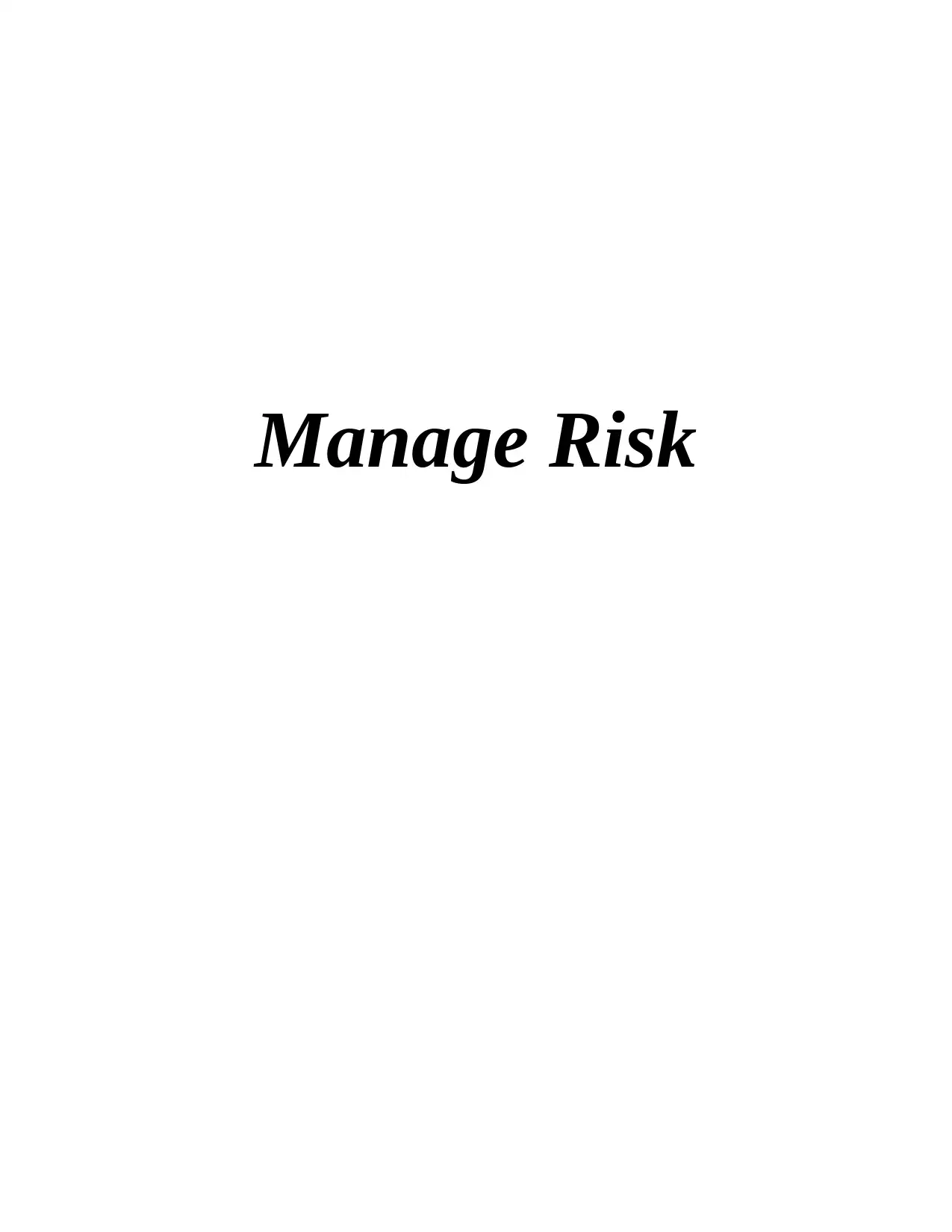
Manage Risk
Paraphrase This Document
Need a fresh take? Get an instant paraphrase of this document with our AI Paraphraser
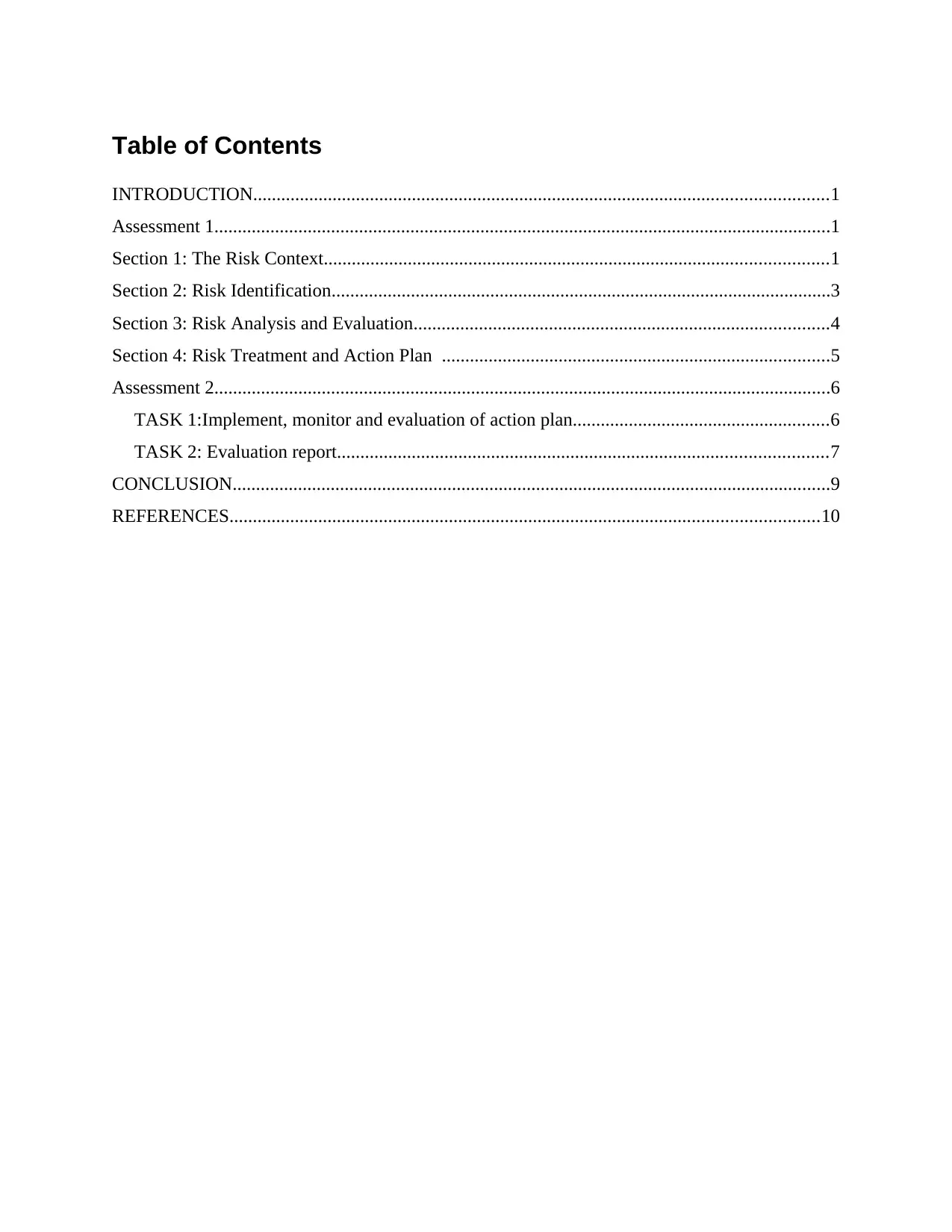
Table of Contents
INTRODUCTION...........................................................................................................................1
Assessment 1....................................................................................................................................1
Section 1: The Risk Context............................................................................................................1
Section 2: Risk Identification...........................................................................................................3
Section 3: Risk Analysis and Evaluation.........................................................................................4
Section 4: Risk Treatment and Action Plan ...................................................................................5
Assessment 2....................................................................................................................................6
TASK 1:Implement, monitor and evaluation of action plan.......................................................6
TASK 2: Evaluation report.........................................................................................................7
CONCLUSION................................................................................................................................9
REFERENCES..............................................................................................................................10
INTRODUCTION...........................................................................................................................1
Assessment 1....................................................................................................................................1
Section 1: The Risk Context............................................................................................................1
Section 2: Risk Identification...........................................................................................................3
Section 3: Risk Analysis and Evaluation.........................................................................................4
Section 4: Risk Treatment and Action Plan ...................................................................................5
Assessment 2....................................................................................................................................6
TASK 1:Implement, monitor and evaluation of action plan.......................................................6
TASK 2: Evaluation report.........................................................................................................7
CONCLUSION................................................................................................................................9
REFERENCES..............................................................................................................................10
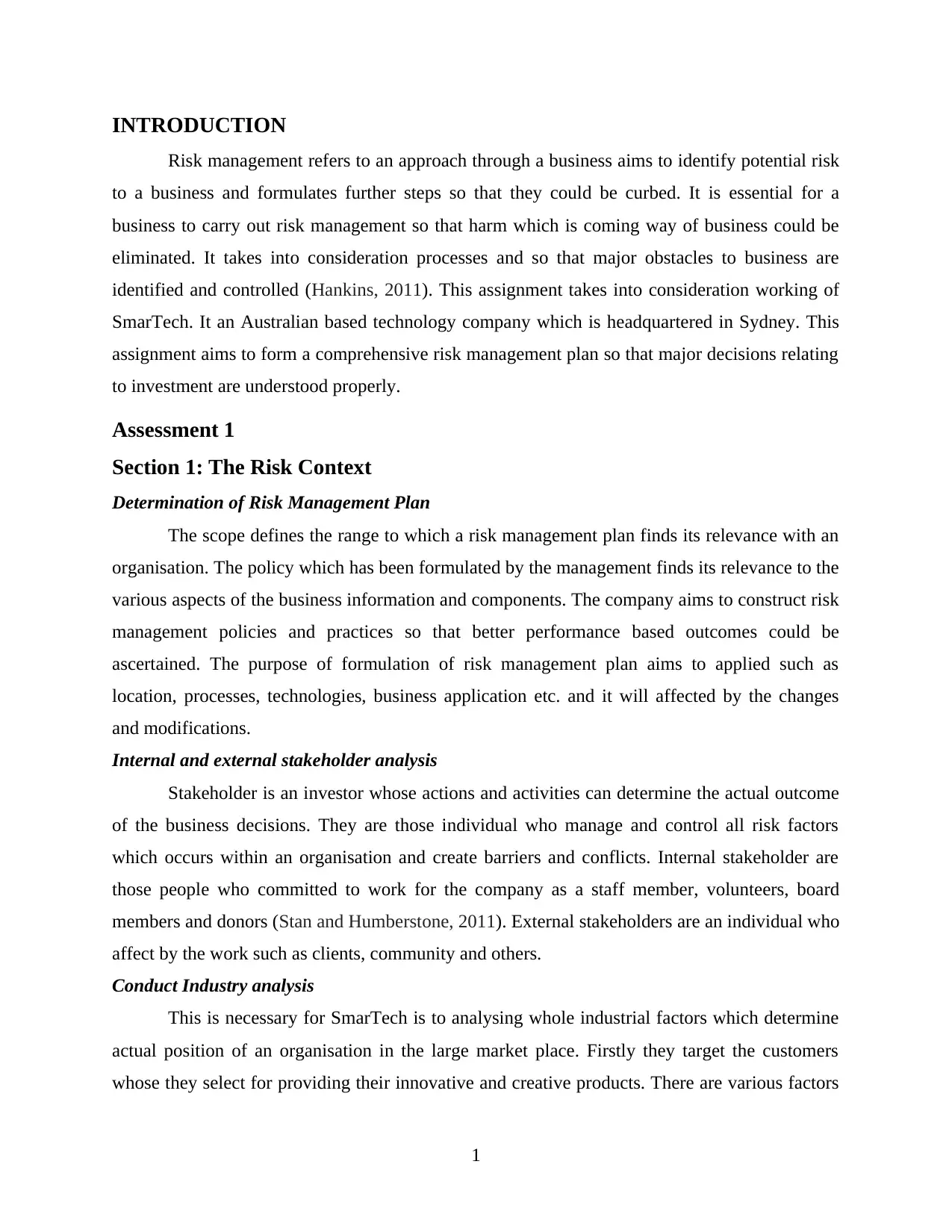
INTRODUCTION
Risk management refers to an approach through a business aims to identify potential risk
to a business and formulates further steps so that they could be curbed. It is essential for a
business to carry out risk management so that harm which is coming way of business could be
eliminated. It takes into consideration processes and so that major obstacles to business are
identified and controlled (Hankins, 2011). This assignment takes into consideration working of
SmarTech. It an Australian based technology company which is headquartered in Sydney. This
assignment aims to form a comprehensive risk management plan so that major decisions relating
to investment are understood properly.
Assessment 1
Section 1: The Risk Context
Determination of Risk Management Plan
The scope defines the range to which a risk management plan finds its relevance with an
organisation. The policy which has been formulated by the management finds its relevance to the
various aspects of the business information and components. The company aims to construct risk
management policies and practices so that better performance based outcomes could be
ascertained. The purpose of formulation of risk management plan aims to applied such as
location, processes, technologies, business application etc. and it will affected by the changes
and modifications.
Internal and external stakeholder analysis
Stakeholder is an investor whose actions and activities can determine the actual outcome
of the business decisions. They are those individual who manage and control all risk factors
which occurs within an organisation and create barriers and conflicts. Internal stakeholder are
those people who committed to work for the company as a staff member, volunteers, board
members and donors (Stan and Humberstone, 2011). External stakeholders are an individual who
affect by the work such as clients, community and others.
Conduct Industry analysis
This is necessary for SmarTech is to analysing whole industrial factors which determine
actual position of an organisation in the large market place. Firstly they target the customers
whose they select for providing their innovative and creative products. There are various factors
1
Risk management refers to an approach through a business aims to identify potential risk
to a business and formulates further steps so that they could be curbed. It is essential for a
business to carry out risk management so that harm which is coming way of business could be
eliminated. It takes into consideration processes and so that major obstacles to business are
identified and controlled (Hankins, 2011). This assignment takes into consideration working of
SmarTech. It an Australian based technology company which is headquartered in Sydney. This
assignment aims to form a comprehensive risk management plan so that major decisions relating
to investment are understood properly.
Assessment 1
Section 1: The Risk Context
Determination of Risk Management Plan
The scope defines the range to which a risk management plan finds its relevance with an
organisation. The policy which has been formulated by the management finds its relevance to the
various aspects of the business information and components. The company aims to construct risk
management policies and practices so that better performance based outcomes could be
ascertained. The purpose of formulation of risk management plan aims to applied such as
location, processes, technologies, business application etc. and it will affected by the changes
and modifications.
Internal and external stakeholder analysis
Stakeholder is an investor whose actions and activities can determine the actual outcome
of the business decisions. They are those individual who manage and control all risk factors
which occurs within an organisation and create barriers and conflicts. Internal stakeholder are
those people who committed to work for the company as a staff member, volunteers, board
members and donors (Stan and Humberstone, 2011). External stakeholders are an individual who
affect by the work such as clients, community and others.
Conduct Industry analysis
This is necessary for SmarTech is to analysing whole industrial factors which determine
actual position of an organisation in the large market place. Firstly they target the customers
whose they select for providing their innovative and creative products. There are various factors
1
⊘ This is a preview!⊘
Do you want full access?
Subscribe today to unlock all pages.

Trusted by 1+ million students worldwide
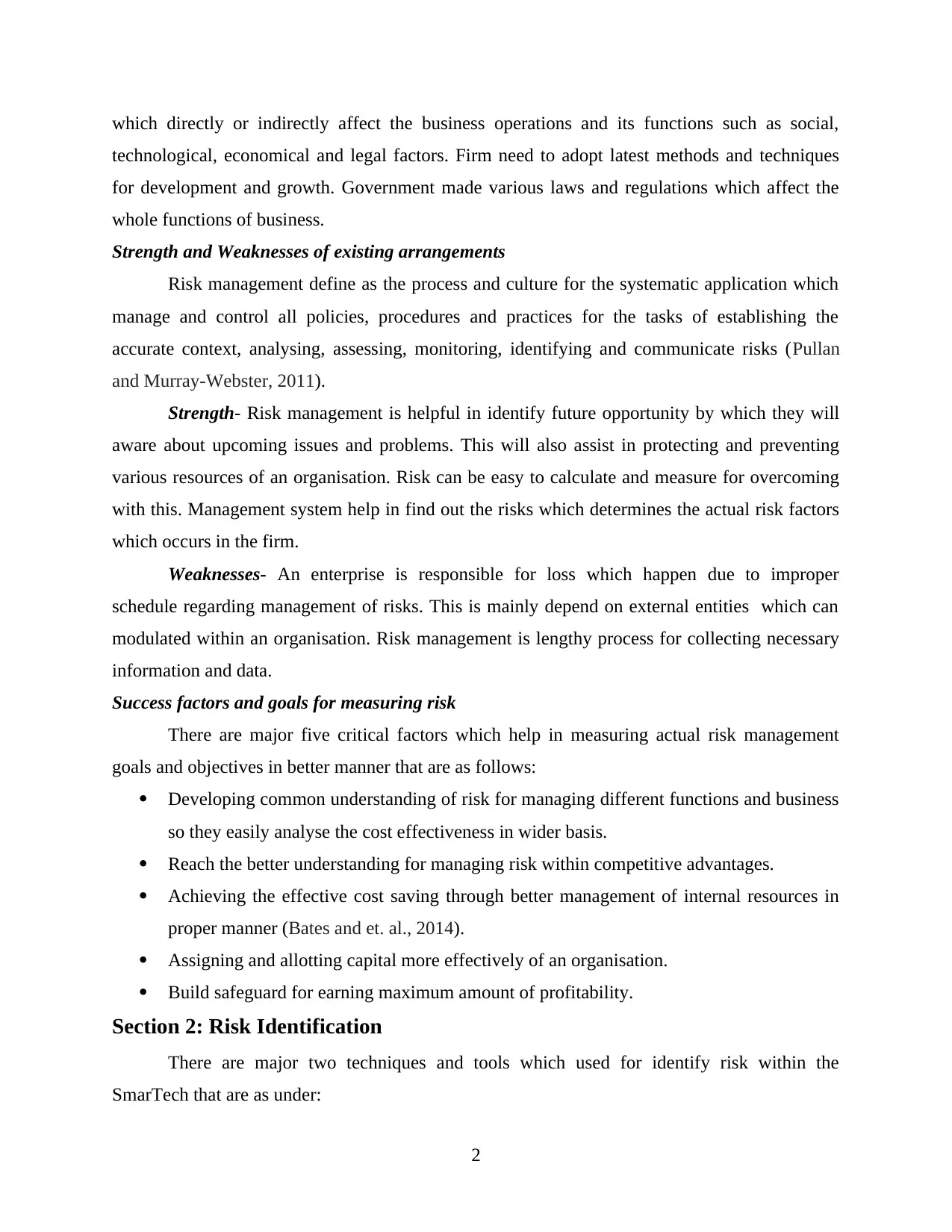
which directly or indirectly affect the business operations and its functions such as social,
technological, economical and legal factors. Firm need to adopt latest methods and techniques
for development and growth. Government made various laws and regulations which affect the
whole functions of business.
Strength and Weaknesses of existing arrangements
Risk management define as the process and culture for the systematic application which
manage and control all policies, procedures and practices for the tasks of establishing the
accurate context, analysing, assessing, monitoring, identifying and communicate risks (Pullan
and Murray-Webster, 2011).
Strength- Risk management is helpful in identify future opportunity by which they will
aware about upcoming issues and problems. This will also assist in protecting and preventing
various resources of an organisation. Risk can be easy to calculate and measure for overcoming
with this. Management system help in find out the risks which determines the actual risk factors
which occurs in the firm.
Weaknesses- An enterprise is responsible for loss which happen due to improper
schedule regarding management of risks. This is mainly depend on external entities which can
modulated within an organisation. Risk management is lengthy process for collecting necessary
information and data.
Success factors and goals for measuring risk
There are major five critical factors which help in measuring actual risk management
goals and objectives in better manner that are as follows:
Developing common understanding of risk for managing different functions and business
so they easily analyse the cost effectiveness in wider basis.
Reach the better understanding for managing risk within competitive advantages.
Achieving the effective cost saving through better management of internal resources in
proper manner (Bates and et. al., 2014).
Assigning and allotting capital more effectively of an organisation.
Build safeguard for earning maximum amount of profitability.
Section 2: Risk Identification
There are major two techniques and tools which used for identify risk within the
SmarTech that are as under:
2
technological, economical and legal factors. Firm need to adopt latest methods and techniques
for development and growth. Government made various laws and regulations which affect the
whole functions of business.
Strength and Weaknesses of existing arrangements
Risk management define as the process and culture for the systematic application which
manage and control all policies, procedures and practices for the tasks of establishing the
accurate context, analysing, assessing, monitoring, identifying and communicate risks (Pullan
and Murray-Webster, 2011).
Strength- Risk management is helpful in identify future opportunity by which they will
aware about upcoming issues and problems. This will also assist in protecting and preventing
various resources of an organisation. Risk can be easy to calculate and measure for overcoming
with this. Management system help in find out the risks which determines the actual risk factors
which occurs in the firm.
Weaknesses- An enterprise is responsible for loss which happen due to improper
schedule regarding management of risks. This is mainly depend on external entities which can
modulated within an organisation. Risk management is lengthy process for collecting necessary
information and data.
Success factors and goals for measuring risk
There are major five critical factors which help in measuring actual risk management
goals and objectives in better manner that are as follows:
Developing common understanding of risk for managing different functions and business
so they easily analyse the cost effectiveness in wider basis.
Reach the better understanding for managing risk within competitive advantages.
Achieving the effective cost saving through better management of internal resources in
proper manner (Bates and et. al., 2014).
Assigning and allotting capital more effectively of an organisation.
Build safeguard for earning maximum amount of profitability.
Section 2: Risk Identification
There are major two techniques and tools which used for identify risk within the
SmarTech that are as under:
2
Paraphrase This Document
Need a fresh take? Get an instant paraphrase of this document with our AI Paraphraser
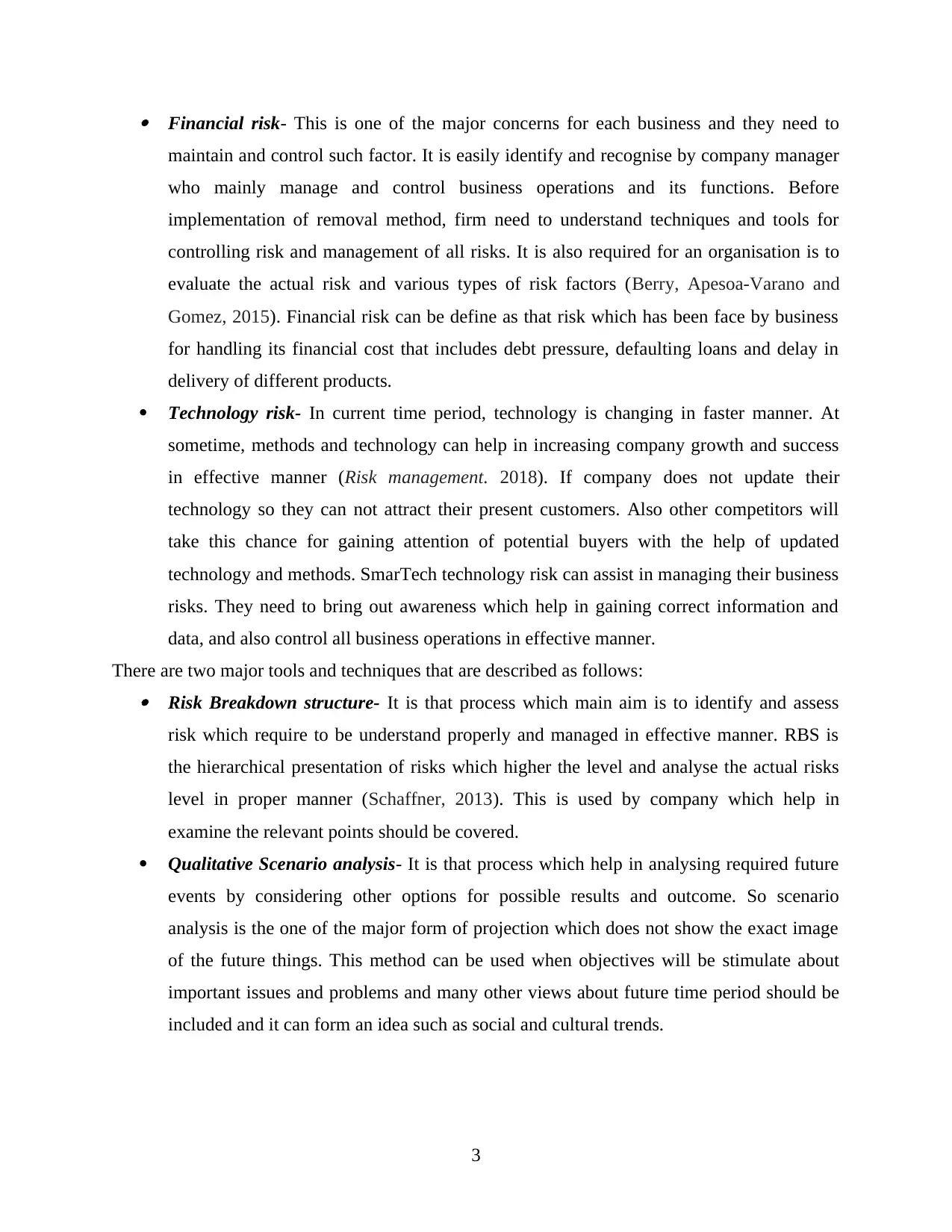
Financial risk- This is one of the major concerns for each business and they need to
maintain and control such factor. It is easily identify and recognise by company manager
who mainly manage and control business operations and its functions. Before
implementation of removal method, firm need to understand techniques and tools for
controlling risk and management of all risks. It is also required for an organisation is to
evaluate the actual risk and various types of risk factors (Berry, Apesoa-Varano and
Gomez, 2015). Financial risk can be define as that risk which has been face by business
for handling its financial cost that includes debt pressure, defaulting loans and delay in
delivery of different products.
Technology risk- In current time period, technology is changing in faster manner. At
sometime, methods and technology can help in increasing company growth and success
in effective manner (Risk management. 2018). If company does not update their
technology so they can not attract their present customers. Also other competitors will
take this chance for gaining attention of potential buyers with the help of updated
technology and methods. SmarTech technology risk can assist in managing their business
risks. They need to bring out awareness which help in gaining correct information and
data, and also control all business operations in effective manner.
There are two major tools and techniques that are described as follows: Risk Breakdown structure- It is that process which main aim is to identify and assess
risk which require to be understand properly and managed in effective manner. RBS is
the hierarchical presentation of risks which higher the level and analyse the actual risks
level in proper manner (Schaffner, 2013). This is used by company which help in
examine the relevant points should be covered.
Qualitative Scenario analysis- It is that process which help in analysing required future
events by considering other options for possible results and outcome. So scenario
analysis is the one of the major form of projection which does not show the exact image
of the future things. This method can be used when objectives will be stimulate about
important issues and problems and many other views about future time period should be
included and it can form an idea such as social and cultural trends.
3
maintain and control such factor. It is easily identify and recognise by company manager
who mainly manage and control business operations and its functions. Before
implementation of removal method, firm need to understand techniques and tools for
controlling risk and management of all risks. It is also required for an organisation is to
evaluate the actual risk and various types of risk factors (Berry, Apesoa-Varano and
Gomez, 2015). Financial risk can be define as that risk which has been face by business
for handling its financial cost that includes debt pressure, defaulting loans and delay in
delivery of different products.
Technology risk- In current time period, technology is changing in faster manner. At
sometime, methods and technology can help in increasing company growth and success
in effective manner (Risk management. 2018). If company does not update their
technology so they can not attract their present customers. Also other competitors will
take this chance for gaining attention of potential buyers with the help of updated
technology and methods. SmarTech technology risk can assist in managing their business
risks. They need to bring out awareness which help in gaining correct information and
data, and also control all business operations in effective manner.
There are two major tools and techniques that are described as follows: Risk Breakdown structure- It is that process which main aim is to identify and assess
risk which require to be understand properly and managed in effective manner. RBS is
the hierarchical presentation of risks which higher the level and analyse the actual risks
level in proper manner (Schaffner, 2013). This is used by company which help in
examine the relevant points should be covered.
Qualitative Scenario analysis- It is that process which help in analysing required future
events by considering other options for possible results and outcome. So scenario
analysis is the one of the major form of projection which does not show the exact image
of the future things. This method can be used when objectives will be stimulate about
important issues and problems and many other views about future time period should be
included and it can form an idea such as social and cultural trends.
3
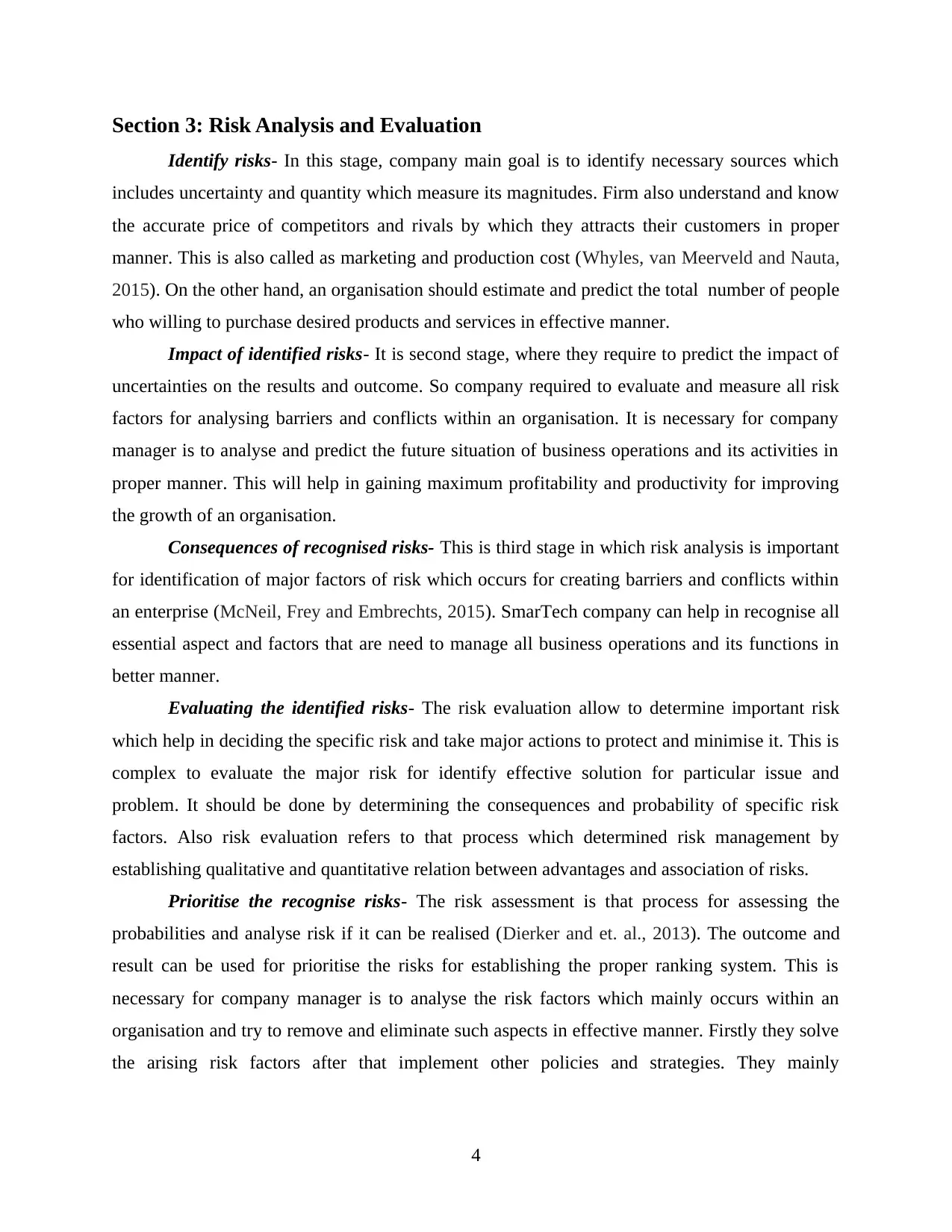
Section 3: Risk Analysis and Evaluation
Identify risks- In this stage, company main goal is to identify necessary sources which
includes uncertainty and quantity which measure its magnitudes. Firm also understand and know
the accurate price of competitors and rivals by which they attracts their customers in proper
manner. This is also called as marketing and production cost (Whyles, van Meerveld and Nauta,
2015). On the other hand, an organisation should estimate and predict the total number of people
who willing to purchase desired products and services in effective manner.
Impact of identified risks- It is second stage, where they require to predict the impact of
uncertainties on the results and outcome. So company required to evaluate and measure all risk
factors for analysing barriers and conflicts within an organisation. It is necessary for company
manager is to analyse and predict the future situation of business operations and its activities in
proper manner. This will help in gaining maximum profitability and productivity for improving
the growth of an organisation.
Consequences of recognised risks- This is third stage in which risk analysis is important
for identification of major factors of risk which occurs for creating barriers and conflicts within
an enterprise (McNeil, Frey and Embrechts, 2015). SmarTech company can help in recognise all
essential aspect and factors that are need to manage all business operations and its functions in
better manner.
Evaluating the identified risks- The risk evaluation allow to determine important risk
which help in deciding the specific risk and take major actions to protect and minimise it. This is
complex to evaluate the major risk for identify effective solution for particular issue and
problem. It should be done by determining the consequences and probability of specific risk
factors. Also risk evaluation refers to that process which determined risk management by
establishing qualitative and quantitative relation between advantages and association of risks.
Prioritise the recognise risks- The risk assessment is that process for assessing the
probabilities and analyse risk if it can be realised (Dierker and et. al., 2013). The outcome and
result can be used for prioritise the risks for establishing the proper ranking system. This is
necessary for company manager is to analyse the risk factors which mainly occurs within an
organisation and try to remove and eliminate such aspects in effective manner. Firstly they solve
the arising risk factors after that implement other policies and strategies. They mainly
4
Identify risks- In this stage, company main goal is to identify necessary sources which
includes uncertainty and quantity which measure its magnitudes. Firm also understand and know
the accurate price of competitors and rivals by which they attracts their customers in proper
manner. This is also called as marketing and production cost (Whyles, van Meerveld and Nauta,
2015). On the other hand, an organisation should estimate and predict the total number of people
who willing to purchase desired products and services in effective manner.
Impact of identified risks- It is second stage, where they require to predict the impact of
uncertainties on the results and outcome. So company required to evaluate and measure all risk
factors for analysing barriers and conflicts within an organisation. It is necessary for company
manager is to analyse and predict the future situation of business operations and its activities in
proper manner. This will help in gaining maximum profitability and productivity for improving
the growth of an organisation.
Consequences of recognised risks- This is third stage in which risk analysis is important
for identification of major factors of risk which occurs for creating barriers and conflicts within
an enterprise (McNeil, Frey and Embrechts, 2015). SmarTech company can help in recognise all
essential aspect and factors that are need to manage all business operations and its functions in
better manner.
Evaluating the identified risks- The risk evaluation allow to determine important risk
which help in deciding the specific risk and take major actions to protect and minimise it. This is
complex to evaluate the major risk for identify effective solution for particular issue and
problem. It should be done by determining the consequences and probability of specific risk
factors. Also risk evaluation refers to that process which determined risk management by
establishing qualitative and quantitative relation between advantages and association of risks.
Prioritise the recognise risks- The risk assessment is that process for assessing the
probabilities and analyse risk if it can be realised (Dierker and et. al., 2013). The outcome and
result can be used for prioritise the risks for establishing the proper ranking system. This is
necessary for company manager is to analyse the risk factors which mainly occurs within an
organisation and try to remove and eliminate such aspects in effective manner. Firstly they solve
the arising risk factors after that implement other policies and strategies. They mainly
4
⊘ This is a preview!⊘
Do you want full access?
Subscribe today to unlock all pages.

Trusted by 1+ million students worldwide
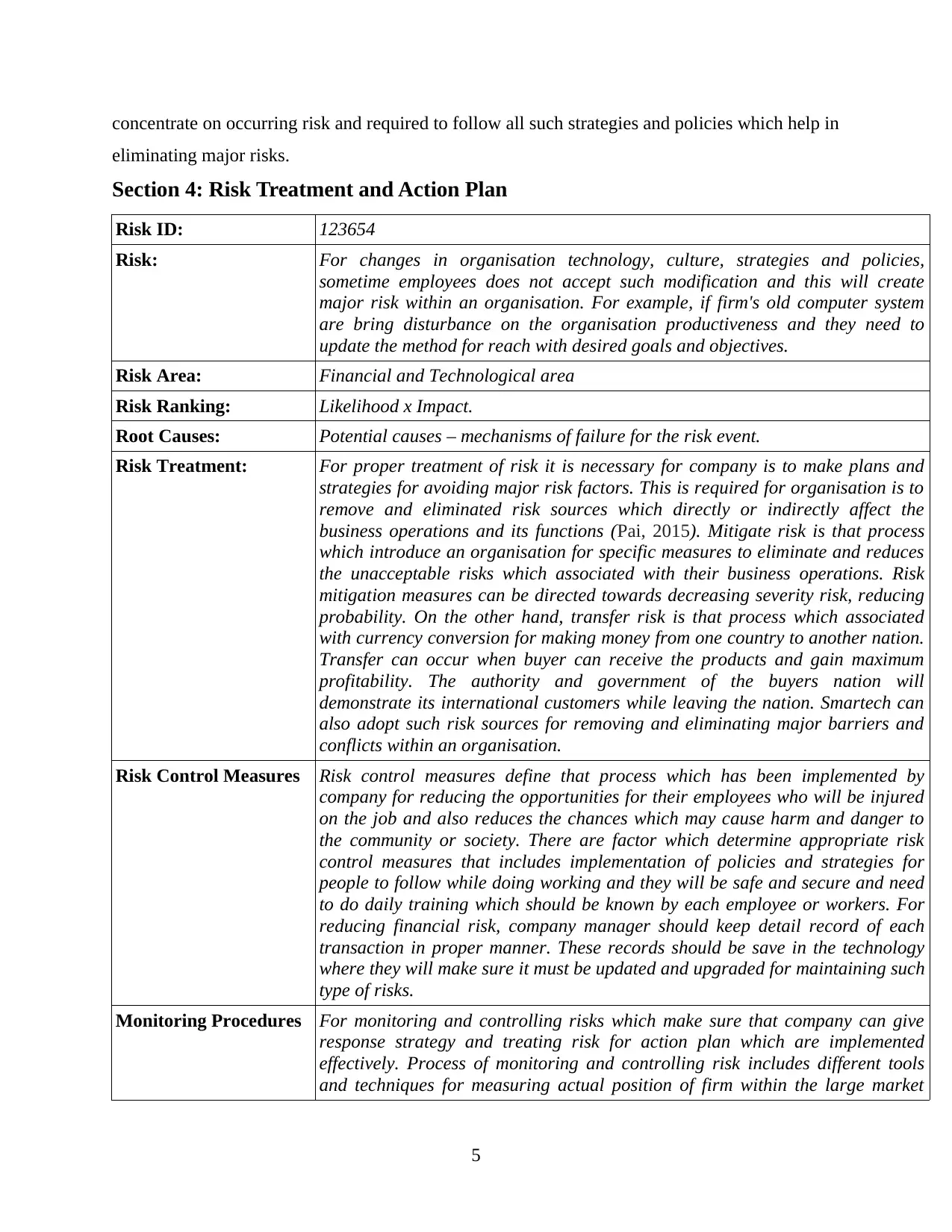
concentrate on occurring risk and required to follow all such strategies and policies which help in
eliminating major risks.
Section 4: Risk Treatment and Action Plan
Risk ID: 123654
Risk: For changes in organisation technology, culture, strategies and policies,
sometime employees does not accept such modification and this will create
major risk within an organisation. For example, if firm's old computer system
are bring disturbance on the organisation productiveness and they need to
update the method for reach with desired goals and objectives.
Risk Area: Financial and Technological area
Risk Ranking: Likelihood x Impact.
Root Causes: Potential causes – mechanisms of failure for the risk event.
Risk Treatment: For proper treatment of risk it is necessary for company is to make plans and
strategies for avoiding major risk factors. This is required for organisation is to
remove and eliminated risk sources which directly or indirectly affect the
business operations and its functions (Pai, 2015). Mitigate risk is that process
which introduce an organisation for specific measures to eliminate and reduces
the unacceptable risks which associated with their business operations. Risk
mitigation measures can be directed towards decreasing severity risk, reducing
probability. On the other hand, transfer risk is that process which associated
with currency conversion for making money from one country to another nation.
Transfer can occur when buyer can receive the products and gain maximum
profitability. The authority and government of the buyers nation will
demonstrate its international customers while leaving the nation. Smartech can
also adopt such risk sources for removing and eliminating major barriers and
conflicts within an organisation.
Risk Control Measures Risk control measures define that process which has been implemented by
company for reducing the opportunities for their employees who will be injured
on the job and also reduces the chances which may cause harm and danger to
the community or society. There are factor which determine appropriate risk
control measures that includes implementation of policies and strategies for
people to follow while doing working and they will be safe and secure and need
to do daily training which should be known by each employee or workers. For
reducing financial risk, company manager should keep detail record of each
transaction in proper manner. These records should be save in the technology
where they will make sure it must be updated and upgraded for maintaining such
type of risks.
Monitoring Procedures For monitoring and controlling risks which make sure that company can give
response strategy and treating risk for action plan which are implemented
effectively. Process of monitoring and controlling risk includes different tools
and techniques for measuring actual position of firm within the large market
5
eliminating major risks.
Section 4: Risk Treatment and Action Plan
Risk ID: 123654
Risk: For changes in organisation technology, culture, strategies and policies,
sometime employees does not accept such modification and this will create
major risk within an organisation. For example, if firm's old computer system
are bring disturbance on the organisation productiveness and they need to
update the method for reach with desired goals and objectives.
Risk Area: Financial and Technological area
Risk Ranking: Likelihood x Impact.
Root Causes: Potential causes – mechanisms of failure for the risk event.
Risk Treatment: For proper treatment of risk it is necessary for company is to make plans and
strategies for avoiding major risk factors. This is required for organisation is to
remove and eliminated risk sources which directly or indirectly affect the
business operations and its functions (Pai, 2015). Mitigate risk is that process
which introduce an organisation for specific measures to eliminate and reduces
the unacceptable risks which associated with their business operations. Risk
mitigation measures can be directed towards decreasing severity risk, reducing
probability. On the other hand, transfer risk is that process which associated
with currency conversion for making money from one country to another nation.
Transfer can occur when buyer can receive the products and gain maximum
profitability. The authority and government of the buyers nation will
demonstrate its international customers while leaving the nation. Smartech can
also adopt such risk sources for removing and eliminating major barriers and
conflicts within an organisation.
Risk Control Measures Risk control measures define that process which has been implemented by
company for reducing the opportunities for their employees who will be injured
on the job and also reduces the chances which may cause harm and danger to
the community or society. There are factor which determine appropriate risk
control measures that includes implementation of policies and strategies for
people to follow while doing working and they will be safe and secure and need
to do daily training which should be known by each employee or workers. For
reducing financial risk, company manager should keep detail record of each
transaction in proper manner. These records should be save in the technology
where they will make sure it must be updated and upgraded for maintaining such
type of risks.
Monitoring Procedures For monitoring and controlling risks which make sure that company can give
response strategy and treating risk for action plan which are implemented
effectively. Process of monitoring and controlling risk includes different tools
and techniques for measuring actual position of firm within the large market
5
Paraphrase This Document
Need a fresh take? Get an instant paraphrase of this document with our AI Paraphraser
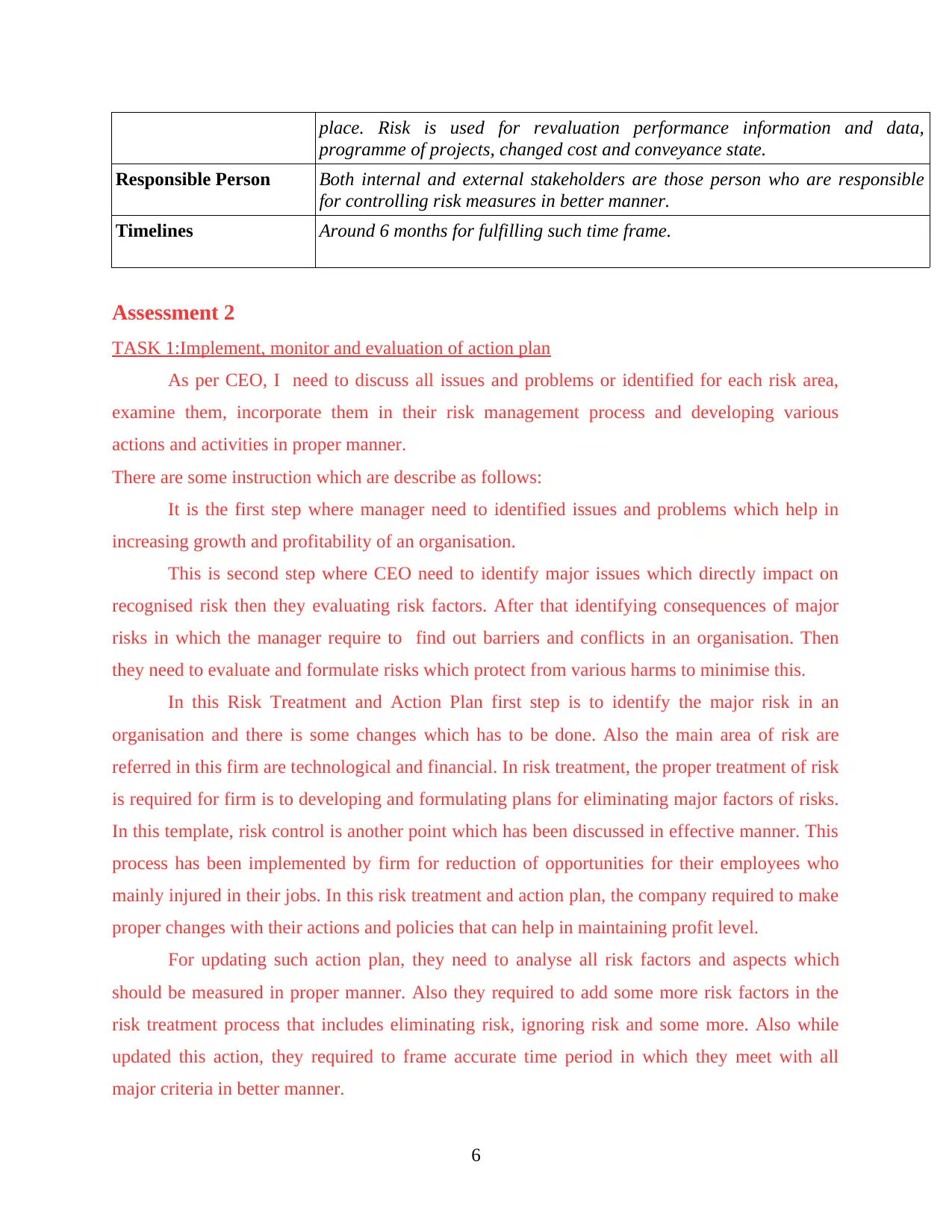
place. Risk is used for revaluation performance information and data,
programme of projects, changed cost and conveyance state.
Responsible Person Both internal and external stakeholders are those person who are responsible
for controlling risk measures in better manner.
Timelines Around 6 months for fulfilling such time frame.
Assessment 2
TASK 1:Implement, monitor and evaluation of action plan
As per CEO, I need to discuss all issues and problems or identified for each risk area,
examine them, incorporate them in their risk management process and developing various
actions and activities in proper manner.
There are some instruction which are describe as follows:
It is the first step where manager need to identified issues and problems which help in
increasing growth and profitability of an organisation.
This is second step where CEO need to identify major issues which directly impact on
recognised risk then they evaluating risk factors. After that identifying consequences of major
risks in which the manager require to find out barriers and conflicts in an organisation. Then
they need to evaluate and formulate risks which protect from various harms to minimise this.
In this Risk Treatment and Action Plan first step is to identify the major risk in an
organisation and there is some changes which has to be done. Also the main area of risk are
referred in this firm are technological and financial. In risk treatment, the proper treatment of risk
is required for firm is to developing and formulating plans for eliminating major factors of risks.
In this template, risk control is another point which has been discussed in effective manner. This
process has been implemented by firm for reduction of opportunities for their employees who
mainly injured in their jobs. In this risk treatment and action plan, the company required to make
proper changes with their actions and policies that can help in maintaining profit level.
For updating such action plan, they need to analyse all risk factors and aspects which
should be measured in proper manner. Also they required to add some more risk factors in the
risk treatment process that includes eliminating risk, ignoring risk and some more. Also while
updated this action, they required to frame accurate time period in which they meet with all
major criteria in better manner.
6
programme of projects, changed cost and conveyance state.
Responsible Person Both internal and external stakeholders are those person who are responsible
for controlling risk measures in better manner.
Timelines Around 6 months for fulfilling such time frame.
Assessment 2
TASK 1:Implement, monitor and evaluation of action plan
As per CEO, I need to discuss all issues and problems or identified for each risk area,
examine them, incorporate them in their risk management process and developing various
actions and activities in proper manner.
There are some instruction which are describe as follows:
It is the first step where manager need to identified issues and problems which help in
increasing growth and profitability of an organisation.
This is second step where CEO need to identify major issues which directly impact on
recognised risk then they evaluating risk factors. After that identifying consequences of major
risks in which the manager require to find out barriers and conflicts in an organisation. Then
they need to evaluate and formulate risks which protect from various harms to minimise this.
In this Risk Treatment and Action Plan first step is to identify the major risk in an
organisation and there is some changes which has to be done. Also the main area of risk are
referred in this firm are technological and financial. In risk treatment, the proper treatment of risk
is required for firm is to developing and formulating plans for eliminating major factors of risks.
In this template, risk control is another point which has been discussed in effective manner. This
process has been implemented by firm for reduction of opportunities for their employees who
mainly injured in their jobs. In this risk treatment and action plan, the company required to make
proper changes with their actions and policies that can help in maintaining profit level.
For updating such action plan, they need to analyse all risk factors and aspects which
should be measured in proper manner. Also they required to add some more risk factors in the
risk treatment process that includes eliminating risk, ignoring risk and some more. Also while
updated this action, they required to frame accurate time period in which they meet with all
major criteria in better manner.
6
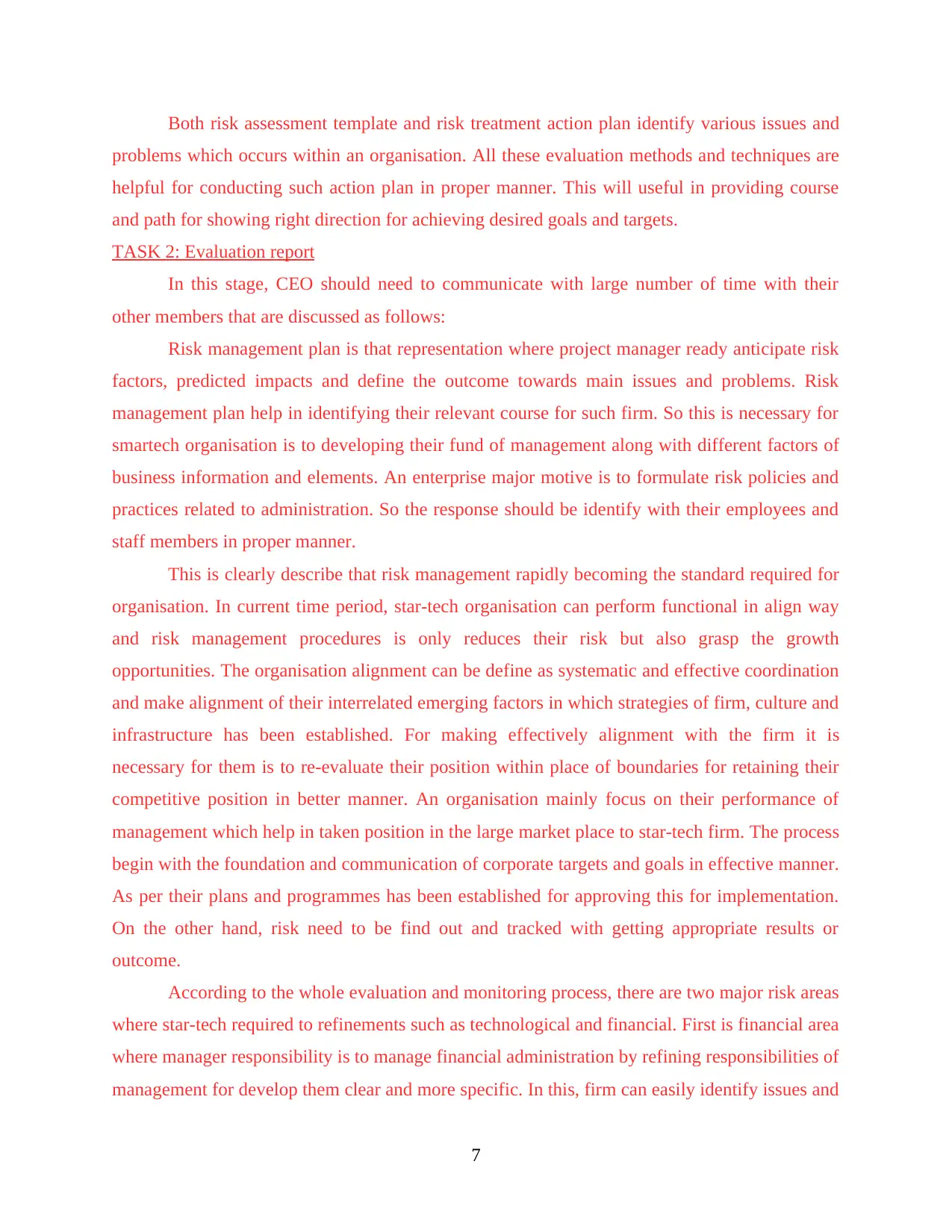
Both risk assessment template and risk treatment action plan identify various issues and
problems which occurs within an organisation. All these evaluation methods and techniques are
helpful for conducting such action plan in proper manner. This will useful in providing course
and path for showing right direction for achieving desired goals and targets.
TASK 2: Evaluation report
In this stage, CEO should need to communicate with large number of time with their
other members that are discussed as follows:
Risk management plan is that representation where project manager ready anticipate risk
factors, predicted impacts and define the outcome towards main issues and problems. Risk
management plan help in identifying their relevant course for such firm. So this is necessary for
smartech organisation is to developing their fund of management along with different factors of
business information and elements. An enterprise major motive is to formulate risk policies and
practices related to administration. So the response should be identify with their employees and
staff members in proper manner.
This is clearly describe that risk management rapidly becoming the standard required for
organisation. In current time period, star-tech organisation can perform functional in align way
and risk management procedures is only reduces their risk but also grasp the growth
opportunities. The organisation alignment can be define as systematic and effective coordination
and make alignment of their interrelated emerging factors in which strategies of firm, culture and
infrastructure has been established. For making effectively alignment with the firm it is
necessary for them is to re-evaluate their position within place of boundaries for retaining their
competitive position in better manner. An organisation mainly focus on their performance of
management which help in taken position in the large market place to star-tech firm. The process
begin with the foundation and communication of corporate targets and goals in effective manner.
As per their plans and programmes has been established for approving this for implementation.
On the other hand, risk need to be find out and tracked with getting appropriate results or
outcome.
According to the whole evaluation and monitoring process, there are two major risk areas
where star-tech required to refinements such as technological and financial. First is financial area
where manager responsibility is to manage financial administration by refining responsibilities of
management for develop them clear and more specific. In this, firm can easily identify issues and
7
problems which occurs within an organisation. All these evaluation methods and techniques are
helpful for conducting such action plan in proper manner. This will useful in providing course
and path for showing right direction for achieving desired goals and targets.
TASK 2: Evaluation report
In this stage, CEO should need to communicate with large number of time with their
other members that are discussed as follows:
Risk management plan is that representation where project manager ready anticipate risk
factors, predicted impacts and define the outcome towards main issues and problems. Risk
management plan help in identifying their relevant course for such firm. So this is necessary for
smartech organisation is to developing their fund of management along with different factors of
business information and elements. An enterprise major motive is to formulate risk policies and
practices related to administration. So the response should be identify with their employees and
staff members in proper manner.
This is clearly describe that risk management rapidly becoming the standard required for
organisation. In current time period, star-tech organisation can perform functional in align way
and risk management procedures is only reduces their risk but also grasp the growth
opportunities. The organisation alignment can be define as systematic and effective coordination
and make alignment of their interrelated emerging factors in which strategies of firm, culture and
infrastructure has been established. For making effectively alignment with the firm it is
necessary for them is to re-evaluate their position within place of boundaries for retaining their
competitive position in better manner. An organisation mainly focus on their performance of
management which help in taken position in the large market place to star-tech firm. The process
begin with the foundation and communication of corporate targets and goals in effective manner.
As per their plans and programmes has been established for approving this for implementation.
On the other hand, risk need to be find out and tracked with getting appropriate results or
outcome.
According to the whole evaluation and monitoring process, there are two major risk areas
where star-tech required to refinements such as technological and financial. First is financial area
where manager responsibility is to manage financial administration by refining responsibilities of
management for develop them clear and more specific. In this, firm can easily identify issues and
7
⊘ This is a preview!⊘
Do you want full access?
Subscribe today to unlock all pages.

Trusted by 1+ million students worldwide
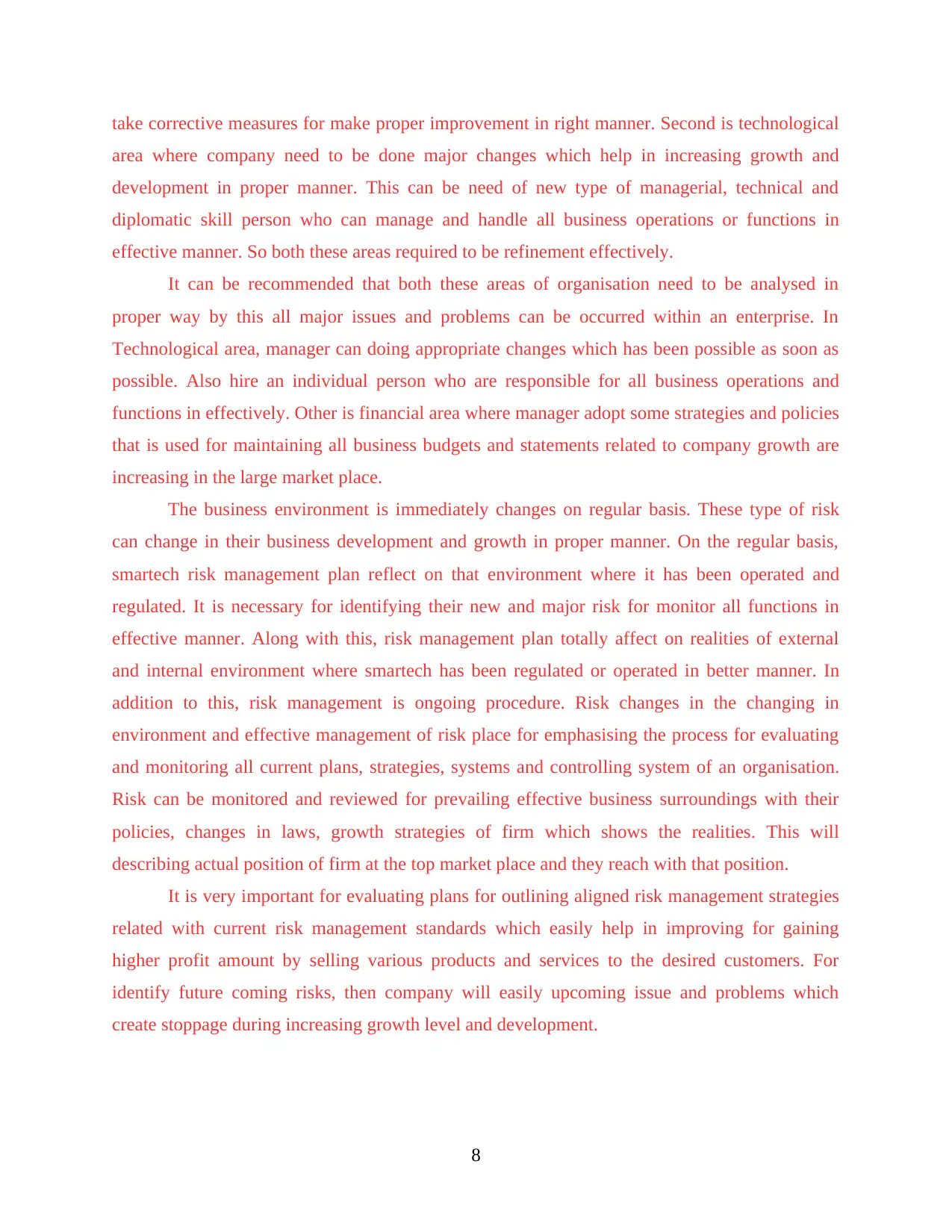
take corrective measures for make proper improvement in right manner. Second is technological
area where company need to be done major changes which help in increasing growth and
development in proper manner. This can be need of new type of managerial, technical and
diplomatic skill person who can manage and handle all business operations or functions in
effective manner. So both these areas required to be refinement effectively.
It can be recommended that both these areas of organisation need to be analysed in
proper way by this all major issues and problems can be occurred within an enterprise. In
Technological area, manager can doing appropriate changes which has been possible as soon as
possible. Also hire an individual person who are responsible for all business operations and
functions in effectively. Other is financial area where manager adopt some strategies and policies
that is used for maintaining all business budgets and statements related to company growth are
increasing in the large market place.
The business environment is immediately changes on regular basis. These type of risk
can change in their business development and growth in proper manner. On the regular basis,
smartech risk management plan reflect on that environment where it has been operated and
regulated. It is necessary for identifying their new and major risk for monitor all functions in
effective manner. Along with this, risk management plan totally affect on realities of external
and internal environment where smartech has been regulated or operated in better manner. In
addition to this, risk management is ongoing procedure. Risk changes in the changing in
environment and effective management of risk place for emphasising the process for evaluating
and monitoring all current plans, strategies, systems and controlling system of an organisation.
Risk can be monitored and reviewed for prevailing effective business surroundings with their
policies, changes in laws, growth strategies of firm which shows the realities. This will
describing actual position of firm at the top market place and they reach with that position.
It is very important for evaluating plans for outlining aligned risk management strategies
related with current risk management standards which easily help in improving for gaining
higher profit amount by selling various products and services to the desired customers. For
identify future coming risks, then company will easily upcoming issue and problems which
create stoppage during increasing growth level and development.
8
area where company need to be done major changes which help in increasing growth and
development in proper manner. This can be need of new type of managerial, technical and
diplomatic skill person who can manage and handle all business operations or functions in
effective manner. So both these areas required to be refinement effectively.
It can be recommended that both these areas of organisation need to be analysed in
proper way by this all major issues and problems can be occurred within an enterprise. In
Technological area, manager can doing appropriate changes which has been possible as soon as
possible. Also hire an individual person who are responsible for all business operations and
functions in effectively. Other is financial area where manager adopt some strategies and policies
that is used for maintaining all business budgets and statements related to company growth are
increasing in the large market place.
The business environment is immediately changes on regular basis. These type of risk
can change in their business development and growth in proper manner. On the regular basis,
smartech risk management plan reflect on that environment where it has been operated and
regulated. It is necessary for identifying their new and major risk for monitor all functions in
effective manner. Along with this, risk management plan totally affect on realities of external
and internal environment where smartech has been regulated or operated in better manner. In
addition to this, risk management is ongoing procedure. Risk changes in the changing in
environment and effective management of risk place for emphasising the process for evaluating
and monitoring all current plans, strategies, systems and controlling system of an organisation.
Risk can be monitored and reviewed for prevailing effective business surroundings with their
policies, changes in laws, growth strategies of firm which shows the realities. This will
describing actual position of firm at the top market place and they reach with that position.
It is very important for evaluating plans for outlining aligned risk management strategies
related with current risk management standards which easily help in improving for gaining
higher profit amount by selling various products and services to the desired customers. For
identify future coming risks, then company will easily upcoming issue and problems which
create stoppage during increasing growth level and development.
8
Paraphrase This Document
Need a fresh take? Get an instant paraphrase of this document with our AI Paraphraser
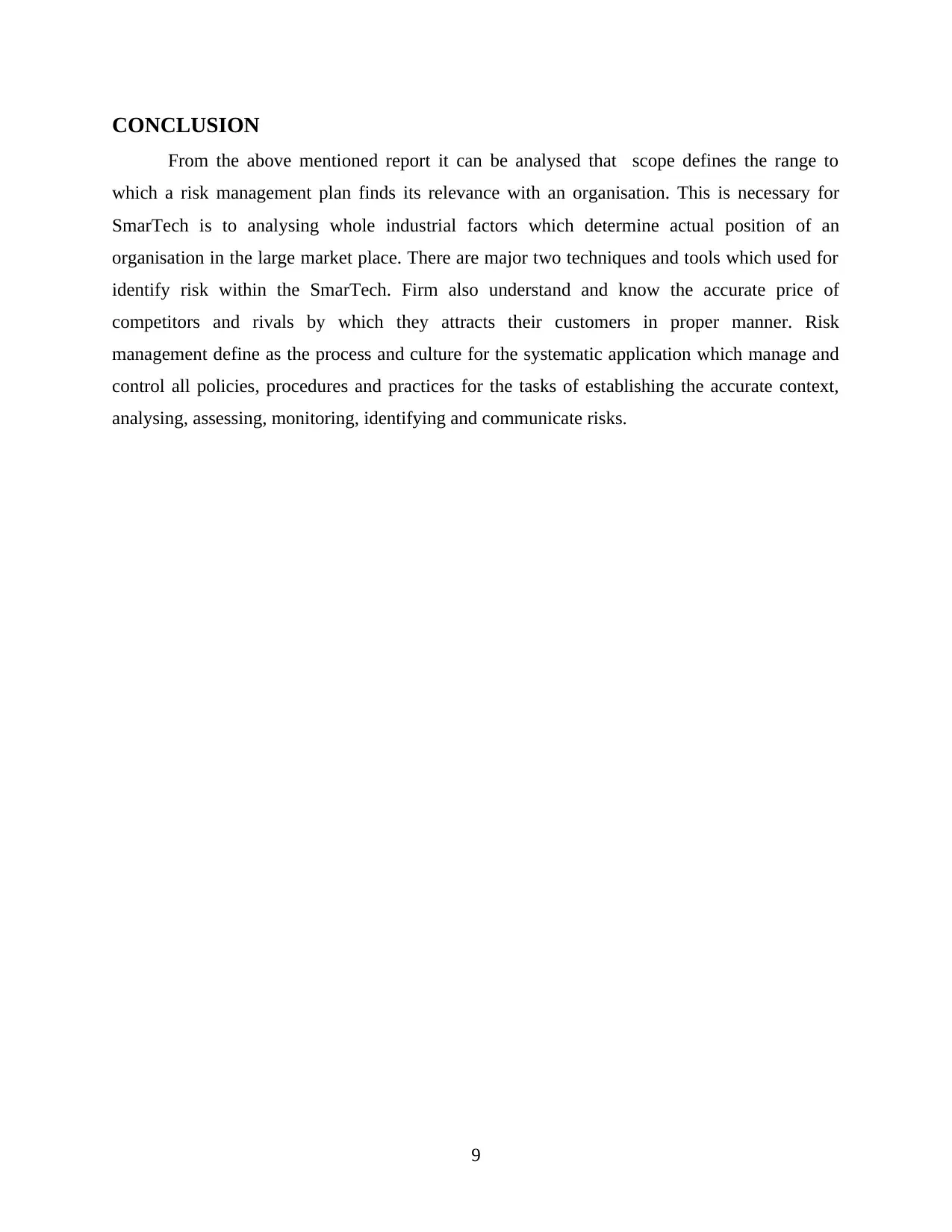
CONCLUSION
From the above mentioned report it can be analysed that scope defines the range to
which a risk management plan finds its relevance with an organisation. This is necessary for
SmarTech is to analysing whole industrial factors which determine actual position of an
organisation in the large market place. There are major two techniques and tools which used for
identify risk within the SmarTech. Firm also understand and know the accurate price of
competitors and rivals by which they attracts their customers in proper manner. Risk
management define as the process and culture for the systematic application which manage and
control all policies, procedures and practices for the tasks of establishing the accurate context,
analysing, assessing, monitoring, identifying and communicate risks.
9
From the above mentioned report it can be analysed that scope defines the range to
which a risk management plan finds its relevance with an organisation. This is necessary for
SmarTech is to analysing whole industrial factors which determine actual position of an
organisation in the large market place. There are major two techniques and tools which used for
identify risk within the SmarTech. Firm also understand and know the accurate price of
competitors and rivals by which they attracts their customers in proper manner. Risk
management define as the process and culture for the systematic application which manage and
control all policies, procedures and practices for the tasks of establishing the accurate context,
analysing, assessing, monitoring, identifying and communicate risks.
9
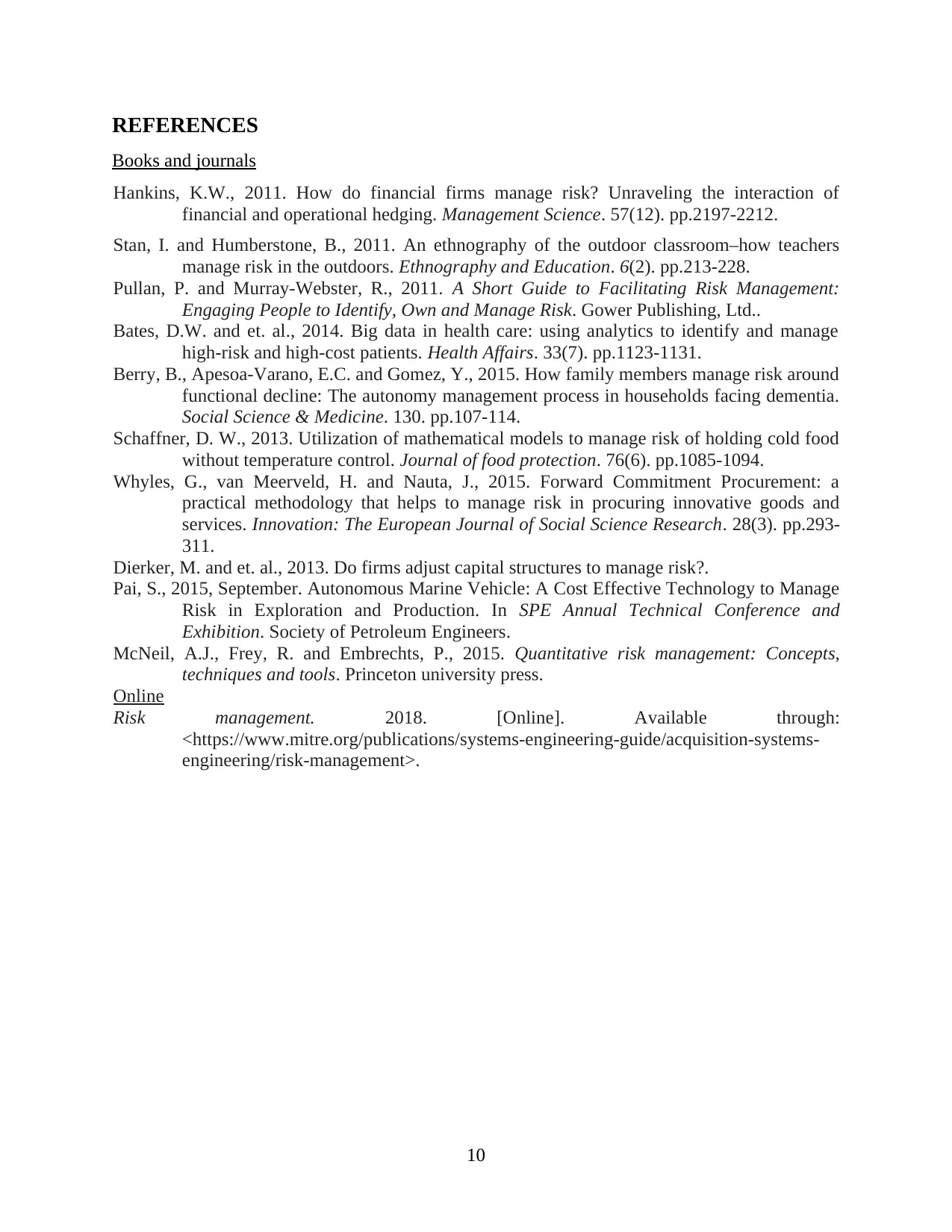
REFERENCES
Books and journals
Hankins, K.W., 2011. How do financial firms manage risk? Unraveling the interaction of
financial and operational hedging. Management Science. 57(12). pp.2197-2212.
Stan, I. and Humberstone, B., 2011. An ethnography of the outdoor classroom–how teachers
manage risk in the outdoors. Ethnography and Education. 6(2). pp.213-228.
Pullan, P. and Murray-Webster, R., 2011. A Short Guide to Facilitating Risk Management:
Engaging People to Identify, Own and Manage Risk. Gower Publishing, Ltd..
Bates, D.W. and et. al., 2014. Big data in health care: using analytics to identify and manage
high-risk and high-cost patients. Health Affairs. 33(7). pp.1123-1131.
Berry, B., Apesoa-Varano, E.C. and Gomez, Y., 2015. How family members manage risk around
functional decline: The autonomy management process in households facing dementia.
Social Science & Medicine. 130. pp.107-114.
Schaffner, D. W., 2013. Utilization of mathematical models to manage risk of holding cold food
without temperature control. Journal of food protection. 76(6). pp.1085-1094.
Whyles, G., van Meerveld, H. and Nauta, J., 2015. Forward Commitment Procurement: a
practical methodology that helps to manage risk in procuring innovative goods and
services. Innovation: The European Journal of Social Science Research. 28(3). pp.293-
311.
Dierker, M. and et. al., 2013. Do firms adjust capital structures to manage risk?.
Pai, S., 2015, September. Autonomous Marine Vehicle: A Cost Effective Technology to Manage
Risk in Exploration and Production. In SPE Annual Technical Conference and
Exhibition. Society of Petroleum Engineers.
McNeil, A.J., Frey, R. and Embrechts, P., 2015. Quantitative risk management: Concepts,
techniques and tools. Princeton university press.
Online
Risk management. 2018. [Online]. Available through:
<https://www.mitre.org/publications/systems-engineering-guide/acquisition-systems-
engineering/risk-management>.
10
Books and journals
Hankins, K.W., 2011. How do financial firms manage risk? Unraveling the interaction of
financial and operational hedging. Management Science. 57(12). pp.2197-2212.
Stan, I. and Humberstone, B., 2011. An ethnography of the outdoor classroom–how teachers
manage risk in the outdoors. Ethnography and Education. 6(2). pp.213-228.
Pullan, P. and Murray-Webster, R., 2011. A Short Guide to Facilitating Risk Management:
Engaging People to Identify, Own and Manage Risk. Gower Publishing, Ltd..
Bates, D.W. and et. al., 2014. Big data in health care: using analytics to identify and manage
high-risk and high-cost patients. Health Affairs. 33(7). pp.1123-1131.
Berry, B., Apesoa-Varano, E.C. and Gomez, Y., 2015. How family members manage risk around
functional decline: The autonomy management process in households facing dementia.
Social Science & Medicine. 130. pp.107-114.
Schaffner, D. W., 2013. Utilization of mathematical models to manage risk of holding cold food
without temperature control. Journal of food protection. 76(6). pp.1085-1094.
Whyles, G., van Meerveld, H. and Nauta, J., 2015. Forward Commitment Procurement: a
practical methodology that helps to manage risk in procuring innovative goods and
services. Innovation: The European Journal of Social Science Research. 28(3). pp.293-
311.
Dierker, M. and et. al., 2013. Do firms adjust capital structures to manage risk?.
Pai, S., 2015, September. Autonomous Marine Vehicle: A Cost Effective Technology to Manage
Risk in Exploration and Production. In SPE Annual Technical Conference and
Exhibition. Society of Petroleum Engineers.
McNeil, A.J., Frey, R. and Embrechts, P., 2015. Quantitative risk management: Concepts,
techniques and tools. Princeton university press.
Online
Risk management. 2018. [Online]. Available through:
<https://www.mitre.org/publications/systems-engineering-guide/acquisition-systems-
engineering/risk-management>.
10
⊘ This is a preview!⊘
Do you want full access?
Subscribe today to unlock all pages.

Trusted by 1+ million students worldwide
1 out of 12
Related Documents
Your All-in-One AI-Powered Toolkit for Academic Success.
+13062052269
info@desklib.com
Available 24*7 on WhatsApp / Email
![[object Object]](/_next/static/media/star-bottom.7253800d.svg)
Unlock your academic potential
Copyright © 2020–2025 A2Z Services. All Rights Reserved. Developed and managed by ZUCOL.





